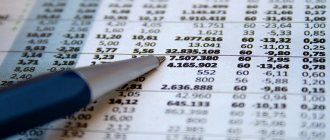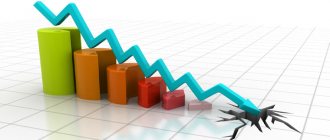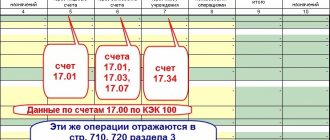How to calculate depreciation using the linear method: basic indicators
Depreciation deductions must be regular.
The cessation of depreciation occurs after the removal of an individual asset from the balance sheet, and its temporary suspension is allowed when an object is transferred to the mothballed group. For calculations, you need to know the size of the following indicators:
- Initial assessment of the object in question. It consists of a set of costs associated with the acquisition or creation of an asset. In the case of a revaluation, the replacement cost is taken as the basis.
- Useful life. Accrual of depreciation using the straight-line method (an example may apply to any non-current asset) is impossible if the period of use is not defined. Its value is important for identifying the depreciation group and deducing the deduction rate (we wrote how to determine this period).
When calculating linear depreciation, the formula takes into account the time period during which the object will actually be listed on the enterprise’s balance sheet and continue to be used. If there has been a transition to a linear method from a non-linear method, then the period of use of the asset used in the calculations is determined by the remaining months of expected operation. Calculation of depreciation charges using the straight-line method in this case will be based not on the initial valuation, but on the value of the residual value.
Accelerated depreciation method
The decreasing balance method (accelerated damping) is a non-linear method of calculating depreciation based on information about the residual value of the beginning of the period, the norm and the coefficient. The latter is chosen by the company, but it is required that it does not exceed 3.
The technique is used for the most part when calculating damped amounts for quickly wearing out or aging equipment. It helps eliminate the weaknesses of the lineman. With its help, it is possible to return up to 75% of the cost of all resources involved in the main activity in only half the period of their operation. Due to linear calculation, only 50% will be returned in the same time.
The reducing balance method of depreciation is used in two ways.
| 1 method | Method 2 |
| In order to write off the value of an object before the end of its operational period, the standard will have to be increased step by step, annually. We look for the norm using the linear method and finally bring it to 100%. | The second method (the method of doubling the reducing balance) lies in calculating the double norm. The final residual value will be written off in the last year. |
| Annual damping value (Ag): Agod = (Sakt – Iz) × NA / 100 Sakt - the cost of the object; NA – damping standard; From - depreciation of the asset at the beginning of the year. | Annual damping value (Ag): Agod = (Sakt – Iz) × 2NA / 100 2NA – depreciation rate multiplied by 2. |
Straight-line depreciation method - formula
To establish the monthly amount of deductions for depreciable property, you must first determine the depreciation rate separately for each object. When linear depreciation is determined, the formula for calculating deductions for different months will be the same. In all cases, the basis is taken as a valuation equal to the value of the original price. It is broken down over all months of use of the asset using the estimated depreciation rate.
The formula for calculating depreciation using the linear method is as follows:
- Valuation of the object x Norm of deductions for the object
Calculation of the depreciation rate in a linear way is carried out by dividing the unit by the value of the operating period. The time period during which the asset will actually be used is shown in months in the calculations. The straight-line depreciation formula in tax accounting requires the mandatory presence of a coefficient in the form of a deduction rate (the indicator is first converted to a percentage).
The procedure for calculating depreciation using the straight-line method involves the start of deductions not from the date of acquisition of the asset, but from the next calendar month. To derive the annual depreciation value, you must use the rate for one year. The annual amount of depreciation can be determined using the linear method by dividing the unit by the operating period calculated in years.
Calculating depreciation using the straight-line method: example
In October 2020, the company bought a car. In accounting, the vehicle was capitalized as a fixed asset at its original cost equal to 890 thousand rubles. According to the unified classifier of depreciation groups, a passenger car should be classified as an asset from group 3 with a useful life in the range of 3-5 years. The owner of the vehicle expects to use it for 5 years (60 months).
In tax accounting, calculating car depreciation using the straight-line method involves calculating annual (or monthly) deduction standards (clause 2 of Article 259.1 of the Tax Code of the Russian Federation).
How to calculate depreciation using the straight-line method - an example with a vehicle that is expected to be used for 5 years:
- The monthly deduction rate is:
1/60 months x 100% = 1.67%.When calculating depreciation using the linear method, using the example of deducing monthly deductions, we focus on the monthly rate. At the end of each month, the car will need to be depreciated as follows:
890,000 rub. x 1.67% = 14,863 rubles.
- How to calculate the depreciation rate using the linear method for the annual amount of deductions: operating years, not months, are substituted into the formula.
The value of this indicator will be equal to1/5 years x 100% = 20%.
Now it is clear? How to calculate depreciation using the straight-line method for the year:
890,000 rub. x 20% = 178,000 rub.
Depreciation using the straight-line method (the example given above reveals the rules for determining depreciation in tax accounting) in accounting will be identical to the amounts from tax accounting if the cost estimates and terms of the asset in operation coincide. Calculating depreciation charges using the straight-line method is not always necessary. The choice of any method for determining the amount of depreciation charges must be approved by the enterprise by an internal administrative document.
Current as of: August 4, 2020
The straight-line method for calculating depreciation of fixed assets and intangible assets is the most common method in accounting and tax accounting. The use of this method is advisable when the economic benefits from the use of a depreciable item flow evenly over its useful life or the flow of such benefits cannot be reliably estimated. Also, the use of the linear method in tax accounting, as opposed to the nonlinear one, is mandatory in some cases. We will show you how to calculate depreciation using the linear method using an example in our consultation.
Linear depreciation formula
For the linear depreciation method, we present formulas that allow us to determine the monthly amount of depreciation (AM) of fixed assets (fixed assets) and intangible assets (IMA) in accordance with the procedure provided for by PBU 6/01, PBU 14/2007 and Ch. 25 Tax Code of the Russian Federation:
| Formula for calculating depreciation using the linear method | ||
| in accounting | in tax accounting | |
| for OS (clause 19 of PBU 6/01) | for intangible assets (clause 29 of PBU 14/2007) | for fixed assets and intangible assets (clause 2 of article 259.1 of the Tax Code of the Russian Federation) |
| AM = C / SPI / 12 where C is the initial or replacement cost of the fixed asset; SPI – useful life of an asset in years | AM = C / SPI where C is the initial or current market value of the intangible asset; SPI – useful life of an intangible asset in months | AM = C * K where C is the initial or replacement cost of an asset or asset; K – depreciation rate of the corresponding object |
How to calculate the depreciation rate using the linear method in tax accounting? This norm, as in accounting, depends on the useful life. Therefore, calculating the depreciation rate using the linear method according to the rules of Ch. 25 of the Tax Code of the Russian Federation looks like this: 1 / SPI * 100%, where SPI is the useful life in months.
Despite the fact that the formulas for calculating depreciation using the linear method in accounting and tax accounting are at first glance different, the procedure for calculating depreciation values is essentially the same.
Therefore, to calculate linear depreciation, the formula for determining the monthly value (A) for simplification can be expressed as follows:
A = C / SPI
where C is the cost of the depreciable object, from which depreciation is calculated;
SPI – useful life of a depreciable object in months.
Method of summing up year numbers
The method of summing up annual numbers (cumulative) helps to carry out the procedure for deducting equipment on the basis of replacement cost, the number of years until the end of the operational period. For the calculation, a figure is taken that is formed by adding the serial numbers of each year of useful use. Ultimately, the value of the equipment, wear and tear, and time of use will impact how depreciation is calculated. Methods of calculating depreciation using other methods make it impossible to compensate for wear and tear so quickly.
| A = (T – n + 1) Sact / Ʃ T - useful life period n - year number Sakt - replacement cost Ʃ — the sum of all years of the asset’s operating period |
This calculation makes it possible to write off up to 80% of the costs of purchasing equipment over 3 years. Having replenished lost assets in a short period of time, the company becomes able to quickly acquire new ones. So, the method of annual numbers insures the company against losses and significantly reduces the risk of depreciation of obsolete assets.
Calculation of depreciation using the straight-line method: example
Let's show how to calculate depreciation using the linear method using an example. It doesn’t matter whether you need to pre-determine the annual amount of depreciation charges in a straight-line manner (as for fixed assets) or whether the monthly amount is immediately calculated, the final values of the monthly amounts in accounting and tax accounting will still be the same.
To confirm, we will provide the calculation of depreciation of a car using the linear method in accounting and tax accounting, and also show how to calculate depreciation using the linear method in accounting for intangible assets (for example, the exclusive right of the author to a computer program).
To calculate depreciation charges using the linear method, we use the same input data for the asset (garbage truck) and intangible asset (exclusive right to the program): the initial cost is 1,750,000 rubles. SPI – 10 years (120 months). In order to determine the amount of depreciation deductions using the linear method, we will use the above formulas.
And we present the calculation of depreciation charges using the linear method in the table:
| The procedure for calculating depreciation using the linear method (example) | ||
| in accounting | in tax accounting | |
| for garbage truck | for exclusive rights to the program | for any of two objects |
| AM = 1,750,000 rubles / 10 years / 12 = 14,583.33 (rubles) | AM = 1,750,000 rubles / 120 months = 14,583.33 (rubles) | |
When is it beneficial to use?
The linear method is often called straight-line, uniform.
Each month the cost of the fixed asset is written off in equal amounts.
When is it convenient? First of all, in cases where the OS object has a long useful life.
For example, in tax accounting, the linear calculation method is even mandatory for buildings, structures, and transfer devices from 8 to 10 depreciation groups.
Thus, the uniform method of deductions is convenient if:
- the asset has a long SPI;
- the characteristics and capabilities of the asset change slowly over time;
- the object is operated evenly throughout its entire service life;
- there is no need to quickly replace or update the fixed asset.
Also, the method is often used by those companies that want to keep the same records for accounting and tax purposes.
The calculation procedure is almost the same, so the differences will be minimal or absent.
Another reason is the organization’s reluctance to understand non-linear methods and to constantly recalculate depreciation.
This is especially true for small enterprises with a small number of fixed assets.
Advantages and disadvantages of the linear method
The main advantages of the linear depreciation method:
- Easy to calculate. The calculation of the amount of deductions needs to be made only once at the beginning of the operation of the property. The amount received will be the same throughout the entire service life.
- Accurate recording of property write-offs. Depreciation deductions occur for each specific object (in contrast to non-linear methods, where depreciation is calculated on the residual value of all objects in the depreciation group).
- Uniform transfer of costs to production costs. With non-linear methods, depreciation charges in the initial period are greater than in the subsequent period (write-off occurs in descending order).
Another advantage is that the legislation provides for the possibility of using this method both in accounting and tax accounting, which avoids the occurrence of differences under PBU 18/02.
The linear method is convenient to use in cases where it is planned that the object will generate the same profit throughout the entire period of its use.
The main disadvantages of the linear method:
The method is not advisable to use for equipment subject to rapid obsolescence, since the proportional write-off of its cost does not ensure the proper concentration of resources necessary for its replacement. Manufacturing equipment is characterized by a decrease in productivity as the number of years of operation increases. As a result, it will require additional costs for maintenance and repairs due to breakdowns and failures. Meanwhile, depreciation will be written off evenly, in the same amounts as at the beginning of operation, since the linear method does not provide otherwise. The total amount of property tax over the entire life of the property to which the linear method is applied will be higher than with non-linear methods. For enterprises planning to quickly update production assets, it will be more convenient to use nonlinear methods.
Pros and cons of linear damping
The linear method of calculating depreciation is indispensable when calculating depreciation of buildings and non-production equipment. It is distinguished by its strong and weak points.
| Positive features of the method | Disadvantages of the method |
|
|
| |
|
Accounting functions are greatly simplified through the use of average standards when calculating depreciation. The linear accrual method is more convenient to adopt in multi-industry corporations. Such companies are characterized by a peak set of fixed assets, while the contribution of a single asset is small. What methods of calculating depreciation solve the problems of linear calculations?
How to calculate depreciation of fixed assets using the straight-line method
To determine the amount of monthly depreciation charges using the straight-line method, it is necessary to have data on the initial cost of the object, establish the useful life and calculate the depreciation rate.
1. Initial cost of the object
The initial cost of an object is calculated by adding up all the costs of its acquisition or construction.
2. Useful life (operational period)
The useful life (operational period) is established by studying the list (classification) of fixed assets, in which fixed assets are divided into depreciation groups.
If the object is not indicated in the list, then its service life is assigned by the organization depending on:
- predicted time of use;
- expected physical wear and tear;
- expected operating conditions.
3. Formula for depreciation rate
The annual depreciation rate is calculated using the formula:
K = (1: n)* 100%,
where K is the annual depreciation rate;
n – service life in years.
If you need to find out the monthly depreciation rate, then the result is divided by 12 (the number of months in a year).
4. The formula for calculating depreciation using the linear method is as follows:
A = PS*K/12,
where A is the amount of monthly depreciation charges;
PS – primary cost of property;
K – depreciation rate, calculated according to the formula in paragraph 3.
If you need to calculate the annual amount of depreciation charges, then you do not need to divide by 12 (the number of months in a year), or it is enough to divide the initial cost of the property by its service life.
Based on these formulas, it becomes clear that the main difference of this method is the uniform transfer of the value of property to the company’s costs.
Thus, it is advisable to use the linear method of calculating depreciation if economic activity is stable, brings uniform profit and does not require rapid write-off of fixed assets.
Linear calculation is not suitable for calculating wear on quickly worn-out objects, with high intensity of production processes, as well as with premature obsolescence of property.
If new production is being developed, it is recommended to slow down the write-off of wear and tear; and in cases where the organization does not lack cash and can promptly update obsolete assets, accelerated depreciation with subsequent replacement of written-off equipment, machinery, tools, etc. would be optimal.
Example. Straight-line depreciation method
The organization purchased passenger vehicles for RUB 400,000. excluding VAT.
According to the classification rules, the car is included in 3 gr.
The useful life is set at 48 months.
To calculate monthly/annual depreciation amounts, you need to determine the annual depreciation rate and then the depreciation amount.
Annual depreciation rate = 1/4 = 25%;
monthly depreciation rate using the straight-line method, expressed as a percentage = 1/48 = 2.083%.
Monthly depreciation = 400,000 rubles. x 2.083% = 8332 rub.
Annual depreciation = 400,000 rubles. x 25% = 100,000 rub.
If the initial cost of the fixed asset and the useful life in tax accounting are established similar, the organization will recognize a monthly expense in the same amount when calculating the income tax base.
Linear accrual system
The straight-line method of calculating depreciation is a calculation based on the replacement cost and time of use of the asset. The value of a capital asset is transferred evenly throughout its operational life. The standards are regulated by a classifier that takes into account operational periods.
| Linear method of calculating depreciation | |
| Agod = Sakt / T | Agod – the totality of depreciation charges for the year; Sakt - cost of equipment; T – operational period. |
The duration of the operation stage of the equipment put on the balance sheet is selected by the owners independently. When the period is not established by technical conditions or approved by management, then the following are taken into account:
- operation restrictions regulated by regulatory documents;
- projected period of application of the fund, planned performance indicators;
- predicted wear as a result of compliance with operating conditions.
| Linear method of calculating depreciation. Formula | ||
| Damping rate taking into account the stage of operation (Na) | Damping amount per year (Agod) | Damping amount per month (Ames) |
| Na = 100/T. Na – standard; T – operational period. | Agod = (Sakt × NA) / 100 Sakt - replacement cost of equipment. | Ames = Agod / 12 |
Postings for calculating depreciation using the straight-line method
When calculating depreciation, standard entries should be made monthly depending on where the fixed asset or intangible asset is used. The accounts used depend not only on the type of depreciable property (for loan 02 - for fixed assets, and 05 - intangible assets), but also on the type of its use. For example, depreciation of industrial objects is reflected, as a rule, in the debit of account 20, and trade organizations usually accrue depreciation in the debit of account 44. The attribution of depreciation to expenses in accounting is reflected by the following entries:
- Debit of account 20 Credit of account 02 - reflects the write-off of depreciation of the object for the main production.
- Debit of account 23 Credit of account 02 - reflects the write-off of depreciation of an auxiliary production facility.
- Debit of account 25 Credit of account 02 - reflects the write-off of depreciation of an object for general production purposes.
- Debit of account 26 Credit of account 02 - reflects the write-off of depreciation of a general purpose object.
- Debit of account 44 Credit of account 02 - reflects the write-off of depreciation of the object of trading companies.
- Debit of account 91 Credit of account 02 - reflects the write-off of depreciation for an object leased.
- Debit of account 20 (23, 25, 26, 44) Credit of account 05 – the write-off of depreciation for intangible assets is reflected.
Linear method of calculating depreciation of fixed assets
The straight-line depreciation method involves writing off the cost of a fixed asset in equal proportional installments over the entire period of its use.
What objects does it apply to?
Each organization has the right to independently choose the method of writing off depreciation charges.
Fixed assets are divided into 10 depreciation groups depending on the time period of their operation. The straight-line depreciation method must be applied to buildings, structures and transmission devices belonging to three groups:
- Group VII - objects with a service life of 20-25 years;
- Group XI – objects with a service life of 25-30 years;
- Group X – objects with a service life of more than 30 years.
For other objects, it is allowed to apply any method of depreciation at the organization’s discretion, as specified in the order on accounting policies.
The straight-line depreciation method can be used both for new property and for objects that were previously in use (operation).
IMPORTANT! Until recently, the chosen depreciation principle could not be changed to another throughout the entire period of deductions for this object. From January 1, 2014, an organization has the right to make a transition from a nonlinear to a linear method once every five years. For the reverse transition - from linear to nonlinear - there are no time restrictions; this can be done at any time, having previously made amendments to the regulations on the accounting policies of the enterprise.
Video - methods for calculating depreciation of fixed assets:
To determine the amount of monthly depreciation deductions using the linear method, it is necessary to know the primary cost of the object, its operational life and calculate the depreciation rate.
Primary cost of the object
The primary cost of the object is used as the basis for calculation, which is calculated by summing up all the costs of its purchase or construction. If the value of the property was revalued, then an indicator such as replacement cost is used for calculation.
Operational period
The operating period is established by studying the classification list of fixed assets, differentiating them into depreciation groups. If the object is not recorded in the list, then its service life is assigned by the organization depending on:
- predicted time of use;
- expected physical wear and tear;
- expected operating conditions.
Depreciation rate formula
The annual depreciation rate is expressed as a percentage of the primary (replacement) cost of the property and is calculated using the formula:
K = (1: n)* 100%,
where K is the annual depreciation rate;
n – service life in years.
If you need to find out the monthly depreciation rate, then the result is divided by 12 (the number of months in a year).
Formula for calculating depreciation
With the linear depreciation method, the calculation formula is:
A = C*K/12,
where A is the amount of monthly depreciation charges;
C – primary cost of property;
K – depreciation rate, calculated according to the formula in paragraph 3.
If you need to calculate the annual amount of depreciation charges, then you do not need to divide by 12 (the number of months in a year), or it is enough to divide the initial cost of the property by its service life.
Depreciation procedure
When calculating depreciation evenly, they are guided by the general rules for making depreciation deductions, namely:
- depreciation must be calculated from the 1st day of the month following the month in which this property was placed on the enterprise’s balance sheet;
- make depreciation charges regardless of financial results;
- make depreciation deductions every month and take them into account in the corresponding tax period;
- grounds for suspending depreciation deductions are considered to be the conservation of an object for a period of 3 months or its long-term repair (more than a year). Contributions resume immediately upon return to service;
- depreciation deductions cease on the 1st day of the month following the month of write-off due to wear and tear, withdrawal from the balance sheet or loss of ownership rights to the property.
The main advantages of the linear depreciation method:
- Easy to calculate. The calculation of the amount of deductions needs to be made only once at the beginning of the operation of the property. The amount received will be the same throughout the entire service life.
- Accurate recording of property write-offs. Depreciation deductions occur for each specific object (in contrast to non-linear methods, where depreciation is calculated on the residual value of all objects in the depreciation group).
- Uniform transfer of costs to production costs. With non-linear methods, depreciation charges in the initial period are greater than in the subsequent period (write-off occurs in descending order).
The linear method is convenient to use in cases where it is planned that the object will generate the same profit throughout the entire period of its use.
The main disadvantages of the linear method:
The method is not advisable to use for equipment subject to rapid obsolescence, since the proportional write-off of its cost does not ensure the proper concentration of resources necessary for its replacement.
Manufacturing equipment is characterized by a decrease in productivity as the number of years of operation increases. As a result, it will require additional costs for maintenance and repairs due to breakdowns and failures. Meanwhile, depreciation will be written off evenly, in the same amounts as at the beginning of operation, since the linear method does not provide otherwise.
For enterprises planning to quickly update production assets, it will be more convenient to use nonlinear methods.
The total amount of property tax over the entire life of the property to which the linear method is applied will be higher than with non-linear methods.
Three pillars of damping
Depreciation of fixed assets and production assets is carried out from the 1st day of the month following the month of their accounting. Removal from the account is accompanied by a stop of accruals on the 1st day of the month following the month of removal from the balance. Along with the disposal of the reserve, the deduction also stops.
Reconstruction, conservation for more than 90 days, major repairs or modernization (more than a year) require stopping accruals. The above basics are elementary, are usually not violated and do not depend on which calculation method is used.
The method of calculating depreciation, the rate and procedure for calculations are not always clear, and other situations raise questions for management. For example, depreciation of reserves used in uneven production across seasons. According to this option, damping is carried out equally during seasonal work.







